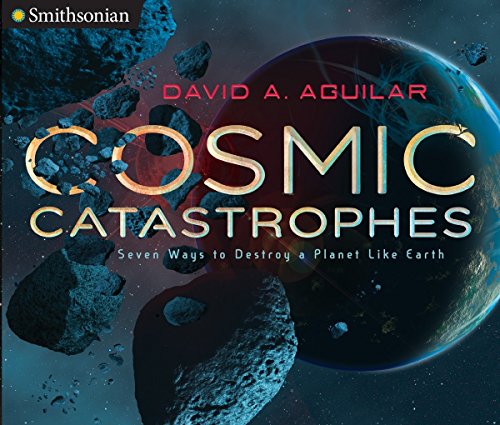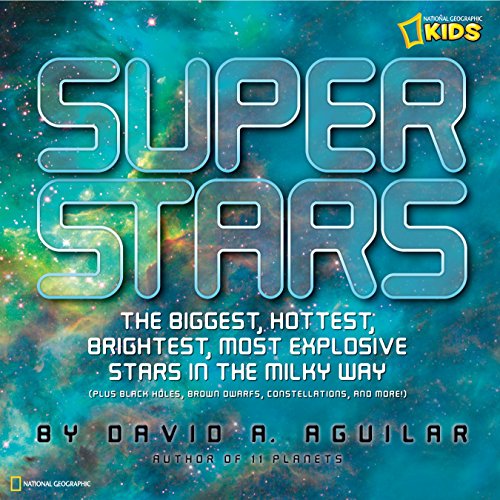-
Cosmic Catastrophes: Seven Ways to Destroy a Planet Like Earth
David A. Aguilar
Hardcover (Viking Books for Young Readers, June 14, 2016)In the vast realm of outer space, accidents happen all the time. Things bump into each other. Stars blow up. Space rocks smash into planets. Black holes gobble up everything in their path. The sun is burning out. A comet swarm is bearing down. Any of this could change—or even eliminate—life on a planet like Earth. Countdown to cosmic catastrophes! From asteroid hit to alien invasion, astronomer David Aguilar builds the scientific case for seven extreme events that could impact Earth. (Though not as we know it: most of these catastrophes are way down the cosmic line . . . we hope!) He tells an exciting nonfiction story about how and why these space catastrophes could happen and then creates beautiful, original art to show just how devastatingly spectacular it will be when any one of these seven “big ones” hit! The SMITHSONIAN INSTITUTION is the world’s largest museum and research complex. Founded in 1846, it includes nineteen museum and galleries, the National Zoological Park, and nine research facilities. Its vast collections house 138 million artifacts, specimens, and works of art, which represent our nation’s rich heritage, art from across the globe, and the immense diversity of the natural and cultural world. V
V
-
13 Planets
David A. Aguilar
PaperbackNone Y
Y
-
Seven Wonders of the Solar System
David A. Aguilar
eBook (Viking Books for Young Readers, May 30, 2017)Travel the near and far reaches of the solar system in this lively, beautifully illustrated Smithsonian nonfiction book!Ready for a wondrous celestial journey? How about a trip to our close neighbor Mars, home to the largest volcano in the solar system? Or to Europa, a watery lunar world with a really deep ocean? Or beyond the beyond to mysterious Planet 9, an unseen giant lurking in the far outer regions of space?This extraordinary book puts you right there: breaking through colorful gaseous hazes; exploring the surface of red-hot or ice-cold planets; hurtling through rings of flying, frozen ice chunks; and rocketing on out to deep space. Astronomer David Aguilar is our navigator on these seven wonderful trips through our solar system—journeys that someday may actually happen! The SMITHSONIAN INSTITUTION is the world’s largest museum and research complex. Founded in 1846, it includes nineteen museum and galleries, the National Zoological Park, and nine research facilities. Its vast collections house 138 million artifacts, specimens, and works of art, which represent our nation’s rich heritage, art from across the globe, and the immense diversity of the natural and cultural world.
-
Cosmic Catastrophes: Seven Ways to Destroy a Planet Like Earth
David A. Aguilar
eBook (Viking Books for Young Readers, June 14, 2016)In the vast realm of outer space, accidents happen all the time. Things bump into each other. Stars blow up. Space rocks smash into planets. Black holes gobble up everything in their path. The sun is burning out. A comet swarm is bearing down. Any of this could change—or even eliminate—life on a planet like Earth. Countdown to cosmic catastrophes! From asteroid hit to alien invasion, astronomer David Aguilar builds the scientific case for seven extreme events that could impact Earth. (Though not as we know it: most of these catastrophes are way down the cosmic line . . . we hope!) He tells an exciting nonfiction story about how and why these space catastrophes could happen and then creates beautiful, original art to show just how devastatingly spectacular it will be when any one of these seven “big ones” hit! The SMITHSONIAN INSTITUTION is the world’s largest museum and research complex. Founded in 1846, it includes nineteen museum and galleries, the National Zoological Park, and nine research facilities. Its vast collections house 138 million artifacts, specimens, and works of art, which represent our nation’s rich heritage, art from across the globe, and the immense diversity of the natural and cultural world.
-
13 Planets: The Latest View of the Solar System
David A. Aguilar
Paperback (National Geographic, March 15, 1732)recent discovery
-
Space Encyclopedia: A Tour of Our Solar System and Beyond
David A. Aguilar
Library Binding (National Geographic Children's Books, Aug. 27, 2013)Presenting the latest exciting findings on space exploration and research and cutting-edge, spectacular views of the universe that technology is bringing back to Earth, all in one ultimate reference book. Authored by David A. Aguilar of the Harvard-Smithsonian Center for Astrophysics, the National Geographic Space Encyclopedia is ideal for the family bookshelf, providing both accessible information for school reports and compelling reading on the mysteries beyond our world. Y
Y
-
Super Stars
David A. Aguilar
Paperback (National Geographic, Jan. 1, 2010)Get to know fifteen amazing super stars that are out of this world! In Super Stars, author David Aguilar uses brilliant photo-realistic illustrations & fascinating up-to-date facts straight from the latest astronomy news to bring you an exciting look at the biggest, hottest, brightest, most explosive stars in the Milky Way. V
V
-
13 Planets: The Latest View of the Solar System
David A. Aguilar
Library Binding (National Geographic Children's Books, March 8, 2011)First, Pluto left. Then it came back, along with Ceres and Eris...and now Haumea and MakeMake, too! The recent actions of the International Astronomical Union have put every solar system book out of date. In response, National Geographic joins forces with David Aguilar of the Harvard Smithsonian Astronomical Observatory to revise our 2008 book—and to update young readers on the high-interest topic of space. Using simple text and spectacular photorealistic computer art by the author, this book profiles all 13 planets in their newly created categories—plus the sun, the Oort Cloud, comets, and other worlds being discovered. Back-of-the-book activities offer hands-on fun for budding astronomers. Y
Y
-
Luna: The Science and Stories of Our Moon
David Aguilar
Library Binding (National Geographic Children's Books, June 11, 2019)Explore the moon from all angles, from its place in the night sky and our solar system to its role in shaping human history and culture.Through gorgeous illustrations and photography, see the moon like you've never seen it before. Read myths of the moon's creation from around the world. Discover the science of how the moon actually formed. Learn all about the moon's effects on Earth's tides and imagine what the world would be like without them. Take a look at moon-men hoaxes from history and find out how scientists may actually colonize Earth's closest neighbor. Weaving together science and myth, history and technology, Luna is perfect for anyone who's ever imagined walking on the moon, wondered about the night sky, or been captivated by a thrilling werewolf story. Y
Y
-
Super Stars: The Biggest, Hottest, Brightest, and Most Explosive Stars in the Milky Way
David A. Aguilar
Library Binding (National Geographic Children's Books, Feb. 23, 2010)Everyone knows that those bright, white dots in the night sky are stars; but how many of us really know what stars are, how they are born, how their lives affect ours, and how they die. SuperStars! is a book to expand the knowledge and fire the imaginations of stargazers everywhere. Expert David Aguilar guides young readers through a galaxy of stars, including the biggest, wariest, and most explosive, not to mention star daycares and "diamonds in the sky". SuperStars! is a title that will intrigue kids and bring all those mesmerizing little dots of light in the night sky to life.. P
P
-
Planets, Stars, and Galaxies: A Visual Encyclopedia of Our Universe
David A. Aguilar
Hardcover (National Geographic Children's Books, Oct. 9, 2007)Finally, it's here! The farthest reaches of our universe captured in atlas form for young readers. Planets, Stars, and Galaxies is the space book that pushes the boundaries of man's ultimate frontier. The engaging, educational text, written in collaboration with National Geographic experts, includes the latest discoveries about our universe; while specially commissioned artwork by the author illuminates page after page. Exciting as well as enlightening, Planets, Stars, and Galaxies belongs on every family bookshelf, providing easy reference for school reports and compelling reading on the myriad mysteries beyond our world. With vivid illustrations and superb photography, this beautiful book puts the wonders of space into every child's hands. This engaging, provocative reference work includes: the new solar system including dwarf planets Pluto, Ceres, and Eris;the latest developments in space exploration, science, and researchhow a star is born and dies, "weird worlds," the "galactic zoo," and more;fun facts about space and amazing new imagesSaturn's rings, Jupiter's moons, and Hubble's deep-space view;first-hand accounts from scientists and astronautswhat it's like to study the universe and to live in space;a fascinating look into our future in space: What space travel might hold in a reader's own lifetimemoon colonies, hotels on Mars? How will the universe end?questions to ponder, such as "Is there other life in the universe?"an illustrated timeline of space research and exploration, star charts, moon maps, fact boxes, and helpful scientific diagrams. Y
Y
-
11 Planets: A New View of the Solar System
David A. Aguilar
Library Binding (National Geographic Children's Books, March 11, 2008)National Geographic proudly presents the essential reference book for what is now officially a NEW AGE in space. In August 2006, the International Astronomical Union redefined the word "planet" and relegated Pluto to the status of a dwarf planet, along with Ceres and Eris. Naturally, National Geographic is there to map out this new view of our solar system. In 11 Planets, David Aguilar, an expert who works on the leading edge of this astounding shift, explains and explores our new galactic knowledge. Using spectacular computer artwork, exclusive to National Geographic, and simple engaging text, this colorful book profiles all 11 planets in our newly categorized solar system: terrestrial Mercury, Venus, Earth, and Mars; gas giants Jupiter, Saturn, Uranus, and Neptune; and dwarf planets Pluto, Ceres, and Eris. The author of the hugely popular Planets, Stars, and Galaxies now leads young minds through into this exciting new view of space, giving readers a vivid "you are there" sensation through his photorealistic artwork. David Aguilar’s 11 Planets is a simple yet compelling introduction to the solar system as it is now classified. This beautiful volume also includes informative spreads on: The Sun Earth’s moon Mars’ moons, Phobos and Diemos Ceres, one of the new dwarf planets The Asteroid Belt Pluto and its moon, Charon Sedna and Eggland, two large Kuiper Belt objects Saturn's rings and moons Comets and the Oort Cloud Other new worlds now being discovered This engaging volume also includes fun activities for young readers. Aguilar’s text presents the latest discoveries in space to young imaginations in a compelling and scientifically accurate way, encouraging understanding of mankind’s new view of our solar system. This is the volume that every library needs; and the book that every child should have access to as the ultimate reference for the new age in space. U
U